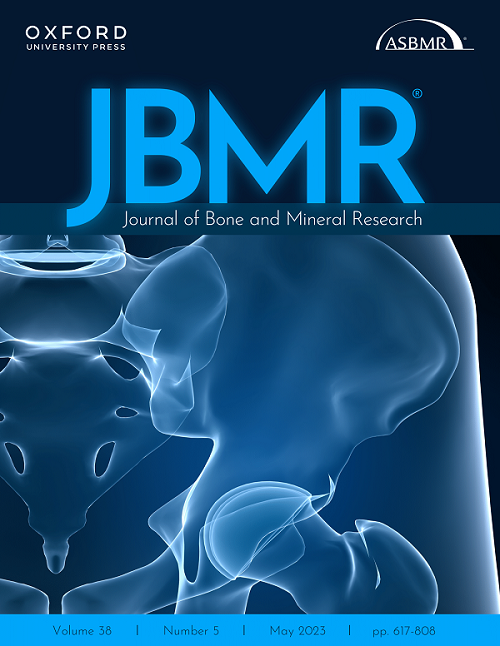Karissa Ludwig, Zenghui Wu, Ghalib Bardai, Patrizia Mason, Leanne M Ward, Pierre Moffatt, Frank Rauch
下载PDF
{"title":"RNA Sequencing of Urine-Derived Cells for the Characterization and Diagnosis of Osteogenesis Imperfecta","authors":"Karissa Ludwig, Zenghui Wu, Ghalib Bardai, Patrizia Mason, Leanne M Ward, Pierre Moffatt, Frank Rauch","doi":"10.1002/jbmr.4865","DOIUrl":null,"url":null,"abstract":"<p>DNA sequencing is a reliable tool for identifying genetic variants in osteogenesis imperfecta (OI) but cannot always establish pathogenicity, particularly in variants altering splicing. RNA sequencing can provide functional evidence of the effect of a variant on the transcript but requires cells expressing the relevant genes. Here, we used urine-derived cells (UDC) to characterize genetic variants in patients with suspected or confirmed OI and provide evidence on the pathogenicity of variants of uncertain significance (VUS). Urine samples were obtained from 45 children and adolescents; UDC culture was successful in 40 of these participants (age range 4–20 years, 21 females), including 18 participants with OI or suspected OI who had a candidate variant or VUS on DNA sequencing. RNA was extracted from UDC and sequenced on an Illumina NextSeq550 device. Principal component analysis showed that the gene expression profiles of UDC and fibroblasts (based on Genotype Tissue Expression [GTEx] Consortium data) clustered close together and had less variability than those of whole blood cells. Transcript abundance was sufficient for analysis by RNA sequencing (defined as a median gene expression level of ≥10 transcripts per million) for 25 of the 32 bone fragility genes (78%) that were included in our diagnostic DNA sequencing panel. These results were similar to GTEx data for fibroblasts. Abnormal splicing was identified in 7 of the 8 participants with pathogenic or likely pathogenic variants in the splice region or deeper within the intron. Abnormal splicing was also observed in 2 VUS (<i>COL1A1</i> c.2829+5G>A and <i>COL1A2</i> c.693+6T>G), but no splice abnormality was observed in 3 other VUS. Abnormal deletions and duplications could also be observed in UDC transcripts. In conclusion, UDC are suitable for RNA transcript analysis in patients with suspected OI and can provide functional evidence for pathogenicity, in particular of variants affecting splicing. © 2023 The Authors. <i>Journal of Bone and Mineral Research</i> published by Wiley Periodicals LLC on behalf of American Society for Bone and Mineral Research (ASBMR).</p>","PeriodicalId":185,"journal":{"name":"Journal of Bone and Mineral Research","volume":"38 8","pages":"1125-1134"},"PeriodicalIF":5.1000,"publicationDate":"2023-06-09","publicationTypes":"Journal Article","fieldsOfStudy":null,"isOpenAccess":false,"openAccessPdf":"https://onlinelibrary.wiley.com/doi/epdf/10.1002/jbmr.4865","citationCount":"0","resultStr":null,"platform":"Semanticscholar","paperid":null,"PeriodicalName":"Journal of Bone and Mineral Research","FirstCategoryId":"3","ListUrlMain":"https://onlinelibrary.wiley.com/doi/10.1002/jbmr.4865","RegionNum":1,"RegionCategory":"医学","ArticlePicture":[],"TitleCN":null,"AbstractTextCN":null,"PMCID":null,"EPubDate":"","PubModel":"","JCR":"Q1","JCRName":"ENDOCRINOLOGY & METABOLISM","Score":null,"Total":0}
引用次数: 0
引用
批量引用
Abstract
DNA sequencing is a reliable tool for identifying genetic variants in osteogenesis imperfecta (OI) but cannot always establish pathogenicity, particularly in variants altering splicing. RNA sequencing can provide functional evidence of the effect of a variant on the transcript but requires cells expressing the relevant genes. Here, we used urine-derived cells (UDC) to characterize genetic variants in patients with suspected or confirmed OI and provide evidence on the pathogenicity of variants of uncertain significance (VUS). Urine samples were obtained from 45 children and adolescents; UDC culture was successful in 40 of these participants (age range 4–20 years, 21 females), including 18 participants with OI or suspected OI who had a candidate variant or VUS on DNA sequencing. RNA was extracted from UDC and sequenced on an Illumina NextSeq550 device. Principal component analysis showed that the gene expression profiles of UDC and fibroblasts (based on Genotype Tissue Expression [GTEx] Consortium data) clustered close together and had less variability than those of whole blood cells. Transcript abundance was sufficient for analysis by RNA sequencing (defined as a median gene expression level of ≥10 transcripts per million) for 25 of the 32 bone fragility genes (78%) that were included in our diagnostic DNA sequencing panel. These results were similar to GTEx data for fibroblasts. Abnormal splicing was identified in 7 of the 8 participants with pathogenic or likely pathogenic variants in the splice region or deeper within the intron. Abnormal splicing was also observed in 2 VUS (COL1A1 c.2829+5G>A and COL1A2 c.693+6T>G), but no splice abnormality was observed in 3 other VUS. Abnormal deletions and duplications could also be observed in UDC transcripts. In conclusion, UDC are suitable for RNA transcript analysis in patients with suspected OI and can provide functional evidence for pathogenicity, in particular of variants affecting splicing. © 2023 The Authors. Journal of Bone and Mineral Research published by Wiley Periodicals LLC on behalf of American Society for Bone and Mineral Research (ASBMR).
尿源性细胞的RNA测序对成骨不全的特征和诊断
DNA测序是鉴定成骨不全症(OI)遗传变异的可靠工具,但不能总是确定致病性,特别是在改变剪接的变异中。RNA测序可以提供变异对转录物影响的功能证据,但需要细胞表达相关基因。在这里,我们使用尿源性细胞(UDC)来表征疑似或确诊成骨不全患者的遗传变异,并为不确定意义变异(VUS)的致病性提供证据。收集了45名儿童和青少年的尿液样本;其中40名参与者(年龄范围4-20岁,21名女性)UDC培养成功,包括18名患有成骨不全或疑似成骨不全的参与者,他们在DNA测序中有候选变异或VUS。从UDC中提取RNA,并在Illumina NextSeq550设备上测序。主成分分析显示,UDC和成纤维细胞的基因表达谱(基于基因型组织表达[GTEx]联盟的数据)聚集在一起,变异性小于全血细胞。转录物丰度足以通过RNA测序(定义为中位数基因表达水平≥每百万10个转录物)对我们诊断性DNA测序面板中32个骨脆性基因中的25个(78%)进行分析。这些结果与成纤维细胞的GTEx数据相似。在8名参与者中,有7名在剪接区域或更深的内含子内发现了致病性或可能致病性变异的异常剪接。2个VUS (COL1A1 c.2829+5G>A和COL1A2 c.693+6T>G)也观察到剪接异常,其他3个VUS未观察到剪接异常。在UDC转录本中也可以观察到异常的缺失和重复。总之,UDC适用于疑似成骨不全患者的RNA转录分析,可以为致病性提供功能证据,特别是影响剪接的变异。©2023作者。由Wiley期刊有限责任公司代表美国骨与矿物研究协会(ASBMR)出版的骨与矿物研究杂志。
本文章由计算机程序翻译,如有差异,请以英文原文为准。

 求助内容:
求助内容: 应助结果提醒方式:
应助结果提醒方式:


